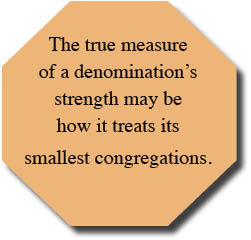 Label a problem “impossible” and you have an excuse for failure.
Label a problem “impossible” and you have an excuse for failure.
This temptation faces today’s Church. In many cases, Church leaders have given up on the Church!
“Neighborhood ministry can’t be supported.” Just declare it! That makes it true.
What happens then?
We stop trying. After all, we have given ourselves permission to fail.
The first to be defeated are the clergy. They throw up their hands and devise ways to make it look like they tried. Assign a caretaker pastor here, an interim pastor there, and pray. Christians support one another in failing ministries. Just look at the statistics.
The laity can only wonder what is discussed at ministerium gatherings of “caretaker” pastors whose assignments are to slowly and quietly bring ministry to a close. It must be deflating. Any pastor who walks in with a new idea is likely to have the conversation quickly changed. The idea is to fail as gracefully as possible.
How can you rebuild self-esteem in a Church where these conditions prevail? Hold grand worship services celebrating Church closures (failures).
Lay people who have more invested in their neighborhood ministries keep working, often under the leadership of defeated pastors, who are called with the tacit understanding that they are to keep things going as long as the money can flow.
Lay leadership is puzzled at the attitudes they encounter, but they soldier on, trying to avoid the conflict brewing from exasperation and a conflict in mission that is never defined — so it can’t be handled.
A defeated attitude spreads like a bad rash. It chafes at the message that is preached from our pulpits. We worship a God of the possible. The Bible is filled cover to cover with accounts of insurmountable obstacles overcome. Some problems are fought with patience, some with trust, and a few with power. The deeper you go in the New Testament, the more faith is relied upon, and thank God for the Book of James, who reminds us that it might take some work.
The Church faces problems today that can be overcome but not if we must first meet all the standards of yesterday’s church. It is time to clear the slate and approach our congregations openly and with the knowledge that with God, all things are possible. If we do not believe that, why bother?
Walk in the shoes of the laity. Would you support a church with no momentum? Would you join a Church that doesn’t believe in its ability to succeed? Would you subscribe to a faith that doesn’t believe its own message?

